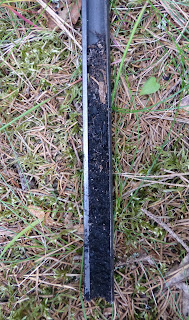Coal for the Masses
After tar kilns, it seems suitable to continue to other rarely researched archaeological remains - charcoal piles. Besides the limited research history, the two also share some similarities through the construction style, basic idea and historical context. However, the remains that are left for today are very different in appearance and charcoal piles are not as easy to spot as the doughnut-like tar kilns. However, thanks to the help of a certain landowner, I managed to visit one in Ulvila.
Charcoal piles were basically constructions to produce charcoal during the historical time - in some extent even during the Iron Age. The idea of the construction is very similar to tar kilns and some charcoal piles were actually built into a dug hole. However, constructions above ground were more dominant in style. In those, wood is piled against each other, covered by turf and a fire is lit inside.
The use of charcoal piles is usually connected to metallurgy, as furnaces required great amounts of charcoal for iron production. While charcoal piles have not been researched more than tar kilns, it's estimated that they were used predominantly from the 17th century to the beginning of the 20th century. However, the use of coal replaced charcoal in many factories already in the 19th century.
I hadn't had much former experience with charcoals piles before my time in Satakunta, but this week I was invited to visit a possible charcoal pile with the landowner Sakari Aalto and journalist Jukka Silvast, so I gladly answered the call!
 Charcoal piles are a bit trickier to survey than many other archaeological remains. They are rarely visible on hillshade models, they appear less on place names and they are not traceable for example by following a certain contour. Easiest way to determine potential areas might be by starting from the end-place of the product - as charcoal was produced for furnaces, piles were reasonably close to ironworks. In this case, the pile that the landowner had discovered was close to the Leineperi ironworks, which had extensive iron production from the 18th to the early 20th century.
Charcoal piles are a bit trickier to survey than many other archaeological remains. They are rarely visible on hillshade models, they appear less on place names and they are not traceable for example by following a certain contour. Easiest way to determine potential areas might be by starting from the end-place of the product - as charcoal was produced for furnaces, piles were reasonably close to ironworks. In this case, the pile that the landowner had discovered was close to the Leineperi ironworks, which had extensive iron production from the 18th to the early 20th century. |
| Clear charcoal layer beginning right after topsoil. |
As the coal piles are not visible on hillshade models, pinpointing a possible area might not help much on the ground, as the piles are not the easiest remains to spot even when looking for them. The most charcoal piles appear only as a low 0,2–1 meters high mounds, which are often surrounded by a slightly visible ditch. There might be some further clues, such as more lush vegetation above the pile, but often a sharp eye is needed to pinpoint the former construction.
In this case, the landowner had found the site during forest management, as a charcoal-covered ground layer had become visible near the pile. Afterwards he had spotted the pile itself, which we now arrived to see. While the photo above gives the site little justice, I was actually surprised about how visible the pile was in this case. Even so, I still did some drilling and found a clearly visible charcoal-layer right under the vegetation.
The charcoal pile was then photographed and measured, after which I took coordinates both of the site itself and from some further drilling samples around the area. While the area had potential for more similar remains, this time only the main pile was marked and protected.
While charcoal piles are as rarely researched as tar kilns, there would be potential to do research especially regarding types, distribution and timing of charcoal piles around Finland. As charcoal piles are so common, not all of them might be needed to preserve, but it would be a pity to neglect the research just because of the high frequency of similar constructions. As with tar kilns, charcoal piles have their own story to tell about the local economies of rural areas and hopefully someday someone will tell that story.
In case you've discovered a coal pile that isn't recorded into the archaeological database, follow these introductions to report it to the Finnish Heritage Agency.
In case you've discovered a coal pile that isn't recorded into the archaeological database, follow these introductions to report it to the Finnish Heritage Agency.



Comments
Post a Comment